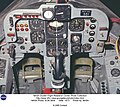File:X-24B Cockpit.jpg

File originale (3 000 × 2 350 pixel, dimensione del file: 4,86 MB, tipo MIME: image/jpeg)
| Questo file e la sua pagina di descrizione (discussione · modifica) si trovano su Wikimedia Commons (?) |
Dettagli
| DescrizioneX-24B Cockpit.jpg |
English: This photo shows the X-24B's cockpit instrumentation panel. The X-24B was the last aircraft to fly in the Dryden Flight Research Center's Lifting Body program. The X-24B's design evolved from a family of potential reentry shapes, each with higher lift-to-drag ratios, proposed by the Air Force Flight Dynamics Laboratory. The X-24B is on public display at the Air Force Museum, Wright-Patterson AFB, Ohio. |
| Data | |
| Fonte | http://www.dfrc.nasa.gov/Gallery/Photo/X-24/HTML/ECN-3659.html (image link) |
| Autore | NASA |
Questa immagine o filmato è stato catalogato dal Armstrong Flight Research Center della National Aeronautics and Space Administration (NASA) degli Stati Uniti d'Americacon il Photo ID: ECN-3659 ET Alternate ID: NIX-ECN-3659.Questo tag non indica lo status del copyright dell'opera ad esso associato. È quindi richiesto un normale tag di copyright. Vedi Commons:Licenze per maggiori informazioni. Altre lingue:
Afrikaans ∙ العربية ∙ беларуская (тарашкевіца) ∙ български ∙ Bahaso Jambi ∙ català ∙ čeština ∙ dansk ∙ Deutsch ∙ English ∙ español ∙ فارسی ∙ français ∙ galego ∙ magyar ∙ հայերեն ∙ Bahasa Indonesia ∙ italiano ∙ 日本語 ∙ македонски ∙ മലയാളം ∙ Nederlands ∙ polski ∙ português ∙ русский ∙ sicilianu ∙ slovenščina ∙ Türkçe ∙ українська ∙ 简体中文 ∙ 繁體中文 ∙ +/− |
Licenza
| Public domainPublic domainfalsefalse |
| Questo file è nel pubblico dominio perché creato dalla NASA. La politica sul copyright della NASA afferma che «il materiale della NASA non è protetto da copyright a meno che non sia specificato altrimenti». (NASA copyright policy e JPL Image Use Policy). |  | |
 |
Attenzione:
|
Didascalie
Elementi ritratti in questo file
raffigura
image/jpeg
Cronologia del file
Fare clic su un gruppo data/ora per vedere il file come si presentava nel momento indicato.
| Data/Ora | Miniatura | Dimensioni | Utente | Commento | |
|---|---|---|---|---|---|
| attuale | 05:20, 16 mag 2021 |  | 3 000 × 2 350 (4,86 MB) | Huntster | Cropped 12 % vertically using CropTool with lossless mode. |
| 17:02, 7 mag 2012 |  | 3 000 × 2 670 (5,21 MB) | Nubifer |
Pagine che usano questo file
La seguente pagina usa questo file:
Metadati
Questo file contiene informazioni aggiuntive, probabilmente aggiunte dalla fotocamera o dallo scanner usati per crearlo o digitalizzarlo. Se il file è stato modificato, alcuni dettagli potrebbero non corrispondere alla realtà.
| Commento del file JPEG | NASA Dryden Flight Research Center Photo Collection
http://www.dfrc.nasa.gov/gallery/photo/index.html NASA Photo: ECN-3659 Date: 1973 Photo by: NASA X-24B Cockpit This photo shows the X-24B's cockpit instrumentation panel. The X-24B was the last aircraft to fly in the Dryden Flight Research Center's Lifting Body program. The X-24B's design evolved from a family of potential reentry shapes, each with higher lift-to-drag ratios, proposed by the Air Force Flight Dynamics Laboratory. The X-24B is on public display at the Air Force Museum, Wright-Patterson AFB, Ohio. The X-24 was one of a group of lifting bodies flown by the NASA Flight Research Center (now Dryden Flight Research Center), Edwards, California, in a joint program with the U.S. Air Force at Edwards Air Force Base from 1963 to 1975. The lifting bodies were used to demonstrate the ability of pilots to maneuver and safely land wingless vehicles designed to fly back to Earth from space and be landed like an airplane at a predetermined site. <p> Lifting bodies’ aerodynamic lift, essential to flight in the atmosphere, was obtained from their shape. The addition of fins and control surfaces allowed the pilots to stabilize and control the vehicles and regulate their flight paths. <p> Built by Martin Aircraft Company, Maryland, for the U.S. Air Force, the X-24A was a bulbous vehicle shaped like a teardrop with three vertical fins at the rear for directional control. It weighed 6,270 pounds, was 24.5 feet long and 11.5 feet wide (measuring just the fuselage, not the distance between the tips of the outboard fins). Its first unpowered glide flight was on April 17, 1969, with Air Force Maj. Jerauld Gentry at the controls. Gentry also piloted its first powered flight on March 19, 1970. <p> The X-24A was flown 28 times in the program that, like the HL-10, validated the concept that a Space Shuttle vehicle could be landed unpowered. The fastest speed achieved by the X-24A was 1,036 miles per hour (mph—Mach 1.6). Its maximum altitude was 71,400 feet. It was powered by an XLR-11 rocket engine with a maximum theoretical vacuum thrust of 8,480 pounds. <p> The X-24A was later modified into the X-24B. The bulbous shape of the X-24A was converted into a "flying flatiron" shape with a rounded top, flat bottom, and double delta platform that ended in a pointed nose. The X-24B demonstrated that accurate unpowered reentry vehicle landings were operationally feasible. Top speed achieved by the X-24B was 1,164 mph and the highest altitude it reached was 74,130 feet. The vehicle is on display at the Air Force Museum, Wright-Patterson Air Force Base, Ohio. The pilot on the last powered flight of the X-24B was Bill Dana, who also flew the last X-15 flight about seven years earlier. <p> The X-24A shape was later borrowed for the X-38 Crew Return Vehicle (CRV) technology demonstrator for the International Space Station. |
|---|
